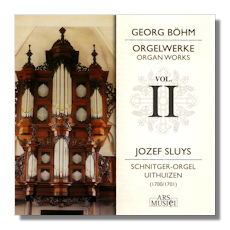
The Internet's Premier Classical Music Source
Related Links
- Böhm Reviews
- Latest Reviews
- More Reviews
-
By Composer
-
Collections
DVD & Blu-ray
Books
Concert Reviews
Articles/Interviews
Software
Audio
Search Amazon
Recommended Links
Site News
 CD Review
CD Review
Georg Böhm

Organ Works II
- Prelude & Fugue in C Major
- Chorale Variations "Christe, der du bist Tag und Licht"
- Chorale "Christ lag in Todesbanden"
- Prelude & Fugue in A minor
- Chorale "Vater unser im Himmelreich" i
- Chorale "Vater unser im Himmelreich" ii
- Chorale "Vater unser in Himmelreich"
- Chorale "Christum Wir sollen loben schon"
- Chorale Partita "Wer nur den lieben Gott lasst walten"
- Chorale Variations "Aus tiefer Not Schrei ich zu dir"
- Prelude in F Major
- Capriccio in D Major
- Chorale "Gelobet seist du Jesu Christ"
- Partita "Wer nur den lieben Gott lasst walten"
- Prelude & Fugue in D minor
Jozef Sluys, organ
Ars Musici 232373
This is the second volume from Ars Musici of the Organ Works of the near contemporary of Bach, Georg Böhm (1661-1733). The first CD (Ars Musici 232342) was reviewed enthusiastically. The organist is Belgian, Jozef Sluys, whose style fits Georg Böhm's dignified and rounded musical creativity admirably.
"Rounded" well describes a musical imagination which (like Bach's) took the contemporary conventions of the instrument and made varied, profound and highly enjoyable works of them to serve both his immediate patrons (churches in Thuringia and Lower Saxony) and a wider audience. Indeed, Böhm's music is in part a synthesis of the strides in organ composition made by the extremely strong and flourishing north German school represented by Schedemann, Weckmann (not 'Weckmannn' [sic] as in the English version of the liner notes' English translation) and Reincken, with whom he studied. That Böhm's organ music was written to so many forms (on this CD there are Preludes and Fugues, Chorales, Chorale variations, Chorale Partitas and a Capriccio) adds to the sense of richness which we experience when listening to this music. Sluys never loses his almost detached – certainly very stately – touch as he approaches each piece in this very well-balanced recital. Furthermore, the feel of the pieces ranges from theatrical calls to attention (The Prelude in C Major [tr.1]) through what sound like familiar "folk" tunes (in some of the Chorale variations on Aus tiefer Not [tr.9]) to delicate but substantial and self-standing explorations of real depth such as the Prelude in F [tr.10].
Sluys' strategy in presenting the dozen or so items of music on this CD to us seems to be to combine thoroughness and comprehensiveness with a firm, almost unspoken belief in how much Böhm's output deserves to be in the repertoire. He takes little for granted, makes sure that every nuance is underlined and set in the context of the practice of the time. And yet reveals the surprises of which Böhm is capable (changes in tempo, unexpected endings and key shifts, for instance) with a light touch. But an authoritative one. As the works explore the concise nature of Böhm's counterpoint, of his rhythms influenced by French style (as in that same Prelude in F) and the influence of Froberger where the dance is prominent, we're also persuaded by the extent to which Böhm is also his own person and able to make new thematic ideas stand on their own regardles of the form chosen. Sluys communicates this aspect of the composer's musical personality clearly and fastidiously.
Sluys plays this sequence on the Schnitger Organ at Uithuizen in the Netherlands. Built in 1701, it was profusely decorated by Jan de Rijk and progressively changed, restored and improved over the next three hundred years. It has a "tidier" and more contained sound than the Waltershausen organ which Sluys plays on Volume I. The surrounding acoustic of this recording (made in 2003, two years after that of the earlier volume) focuses attention on the music nicely with an ideal blend of atmosphere and attention to the organ's strengths. The liner notes are brief, though contain outline details of the works and the organ's registration.
If this CD (and its companion volume) do anything, they securely place Böhm as more than a precursor of Bach. The measured yet insightful playing of Jozef Sluys shows that the older composer (Böhm lived from 1661 to 1733) produced music of interest, beauty and originality. Well worth a look for the purely musical, as well as historical, interest.
Copyright © 2010 by Mark Sealey.





















